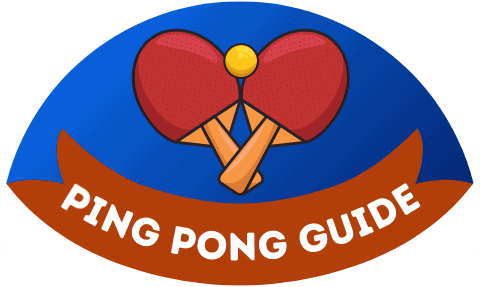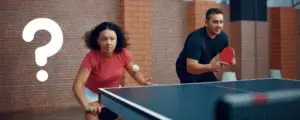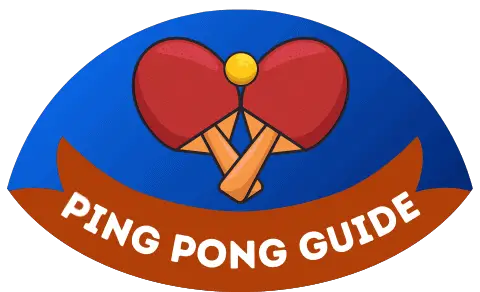You have been playing table tennis regularly for many years, but in some situations, you are still not sure: “Is that allowed?” If you feel the same way, you’ve come to the right place.
In this post, you will learn the official rules for many situations that raise questions. What happens when the ball bounces back due to the spin? Is it allowed to double touch the ball? Is it allowed to volley the ball?
Here you will find the answers to these and more questions.
A small overview for you:
- 1. What happens when the ball bounces back (without contact with the racket) ?
- 2. Can you volley the ball or does it have to bounce?
- 3. What happens when the ball touches the net? – Net Ball
- 4. What happens when the ball hits your finger?
- 5. Touching the ball twice – Is that allowed?
- 6. What happens when the ball bounces on the edge of the table?
- 7. Is it allowed to play around the net?
- Still got questions?
1. What happens when the ball bounces back (without contact with the racket) ?
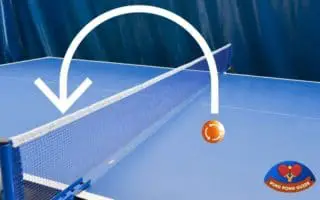
The situation is as follows: Player A hits the serve of player B with a lot of backspin. The ball bounces on player B’s side. It changes direction due to the backspin and bounces back over the net and touches the table again on player A’s side.
This doesn’t happen often but when it does, it often raises questions: Who gets the point or do you just keep playing?
In the above example, Player A is awarded the point.
Why? This situation is not explicitly described in the rules, but one can draw the evaluation of the situation from the rule for the return (2.7.1):
“The ball, having been served or returned, shall be STRUCK so that it touches the opponent’s court, either directly or after touching the net assembly.”
Thus, for a correct return, the ball must be struck. If the ball bounces back to the other side on its own, it is not in compliance with the rules.
As a receiver, it is mandatory to hit the ball. But what do you do if it has already bounced over the net again?
Is it allowed to play the ball above the opponent’s side?
As long as the ball is still in the air after it has bounced back, i.e. it has not yet touched player A’s side, player B may still hit the ball even above the opponent’s court. There is no rule that forbids this.
In this situation, player B could simply go around the table and play the ball straight down.
Funfact: If both players strike the ball so that it bounces back, it can happen that both of them are on the other side of the table at the same time. You can see an example of this unusual situation in this video.
2. Can you volley the ball or does it have to bounce?
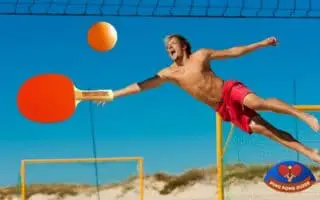
The short answer is: the ball must bounce. Unlike in tennis, it is not allowed to take the ball on the volley.
Let’s look at the corresponding rule:
Rule 5.8 states:
“A player obstructs the ball if he or she, or anything he or she wears or carries, touches it in play when it is above or travelling towards the playing surface, not having touched his or her court since last being struck by his or her opponent.”
So what does this mean in detail?
As long as the ball is still above your own playing surface or flying towards it, you are not allowed to stop it. You are not allowed to hit the ball volley unless it has already missed your own side of the table.
This also means: if the ball is already out of bounds, you may volley it or even catch it. The point is already won. You do not have to wait until it touches the ground.
3. What happens when the ball touches the net? – Net Ball
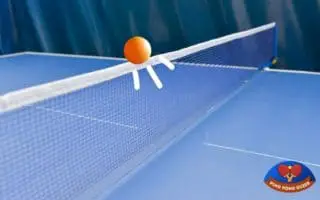
When the ball first touches the net and then the opponent’s side of the table, it is called a net ball.
Net Ball during the rally
When a net ball happens during the rally, play simply continues normally. For this, let’s look at the rule for the return again:
“The ball, having been served or returned, shall be struck so that it touches the opponent’s court, either directly or after touching the net assembly.“
It is common to apologize to the opponent in that case, as net balls often lead to points that are quite unintentional.
Net Ball on serve
If a net ball happens on the serve (all rules for the serve can be found here), it is called a let. In this case, the serve is repeated. This is stated in rule 9.1.1:
The rally shall be a let,
“if in service the ball touches the net assembly, provided the service is
otherwise correct or the ball is obstructed by the receiver or his or her
partner;”
Is there a limit to how many times the serve can be repeated?
No, the serve may be repeated as often as necessary as long as the serve is a let.
What happens when the ball bounces off the net posts onto the board?
Usually, the net ball mostly occurs when the ball hits the actual net, but what about the other elements? Do they count as part of the net?
Yes net posts, the clamps and the suspension (and everything else that goes with it) is counted as part of the net set:
Rule 2.2.1:
“The net assembly shall consist of the net, its suspension and the supporting
posts, including the clamps attaching them to the table.”
Thus, all the points discussed apply not only to the actual net, but to the entire assembly. Accordingly, it is within the rules for the ball to bounce off the post or suspension and onto the opponent’s table.
4. What happens when the ball hits your finger?

It happens so easily that you hit the ball with your finger instead of the racket. But is that actually officially allowed?
Yes, it is allowed to touch the ball with the racket hand from the wrist. If the ball bounces on the finger, this is okay and will not be counted as a point for the opponent.
We have dedicated a whole article to this topic. Click here if you want to learn more about when you are allowed to touch the ball with your hand.
5. Touching the ball twice – Is that allowed?
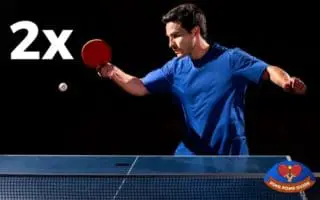
If you don’t hit the ball correctly, it can happen that you touch it more than once in the striking motion. Is this a fault?
This case is described in rule 2.10.1.7.
You are awarded a point…
“if an opponent DELIBERATELY strikes the ball more than once in succession;”
So if you accidentally touch the ball two or more times, it is not considered a fault and the game continues normally.
So theoretically, it would also be possible to touch the ball 10 times. Of course, that never happens in reality.
If a double touch is intentional or not is of course judged by the umpire.
6. What happens when the ball bounces on the edge of the table?
It is called an edge ball when the ball hits the very edge of the table. Similar to the net ball, the edge ball is a common situation in table tennis and often leads directly to a point.
In principle, it is completely within the rules if the ball bounces on the edge of the table.
However, it is important to consider what belongs to the edge of the table. Rule 2.1.2 states:
“The playing surface shall not include the vertical sides of the tabletop.”
Therefore, only the outermost edge of the table surface counts as the table edge. The (outer) sides of the table do not count. If the ball touches them, e.g. when hitting from the side, it is considered a fault.
7. Is it allowed to play around the net?

Yes, the ball may be played around the net as long as it touches the opponent’s side of the table.
In fact, there is no rule at all that restricts how the ball must fly. It is therefore allowed to hit the ball around the net both during the rally and when serving.
The rule on the correct return merely states:
“The ball, having been served or returned, shall be struck so that it touches the opponent’s court, either directly or after touching the net assembly.”
The service rule (6.3) states:
“As the ball is falling the server shall strike it so that it touches first his or her court and then touches directly the receiver’s court; in doubles, the ball shall touch successively the right half court of server and receiver”
So it does not specify how the ball has to fly to touch the opponent’s court.
Still got questions?
I hope I was able to provide the answers you were looking for in this article. If you still have unanswered questions, you might find the right answer in our Q&A Section. Otherwise, you are welcome to use the following form.
Have Fun 🙂
